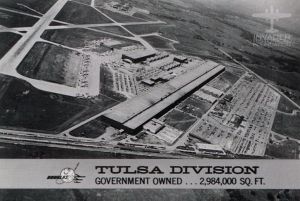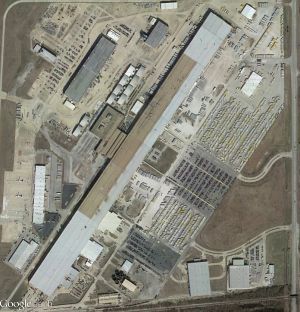Douglas Tulsa
Thanks to the generous contributions and support of David Cantin and Gregory Butler the IHF was able to acquire a very rare set of photographs showing the inside of the Tulsa plant during the height of Invader production in 1944. The original photos are safely preserved in our archive. We've scanned them in at 600DPI and made them available in the highest resolution our server will permit. I made the thumbnails small to keep the page from being unwieldly. Click the photos to view them in higher resolution.
On January 4, 1941, the War Department announced that Tulsa, Oklahama would be the site of a $15 million plant.[1] The Federal Government built Air Force Plant No. 3 on the east side of the airport. The plant was operated by Douglas Aircraft Corporation to manufacture, assemble and modify bombers for the USAAF from 1942 to 1945; production was suspended when World War II ended. The plant was reactivated in 1950 to produce the Boeing B-47 Stratojet and later the Douglas B-66 Destroyer. In 1960 McDonnell Douglas, the successor to Douglas Aircraft Corporation, continued to use the facility for aircraft maintenance. Rockwell International leased part of the plant to manufacture aerospace products. McDonnell Douglas terminated its lease in 1996.[2]
In 1943 President Franklin D. Roosevelt visited the Tulsa plant in secret. Otis Smallwood of Douglas showed him a wooden model of the A-26 that was gearing up for production.
Site Layout
The entire area is 642 acres, of which the US Government owned 52%. [2] All of the buildings on the site comprise a total of 3.8 Million square feet of floor space, of which the US Government owned 73%. [2] The main building is 324 feet across, and 4,004 feet long and 65 feet high and would cost $10.48 Million to build and another $5 Million to equip. [3]
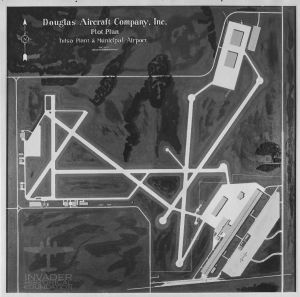
The Southern end of the building had a series of roll-up doors for delivery of material. Two Train Tracks run directly into the south end of the building.
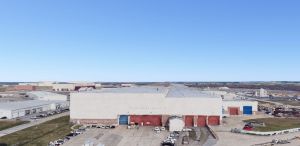
There east side of the building has undergone several changes, with two new attachments on the south end of the building added on.

The west side of the building had to large doors. The southern door had 6 panels and measured 140'. The North door measured 160' and was also 6 panels. The photo entitled "Tulsa Factory at Night" shows this door.

The North side of the building had a small delivery door on the east, and a Massive 12 panel door that measured 200' across. There is a photo of Invaders lined up at Tulsa that was taken in Spring of 1945 that is looking through this door.


Interior Layout
From the picture of the Army Brass inspecting the Tulsa Plant with Douglas Executives we are able to start making sense of what we are seeing with the architectural model. The view from that image shows the camera facing the south, so the finished A-26 models are along the North end, facing the two massive doors on the west wall. We can also see that there are 4 central spine units running down the length of the facility.

Once we start examining the detail of the Architectural photos we see that the walls have numbered beams. The ribs are numbered from S to N, so the lower numbered beams on the south side and the higher numbered beams are on the north side. The space between the beams appears to be 20', so given the length of the building at 4,004' there should be 200 beams - assuming my measurement assumptions are correct. With that background, lets get into the photos.
This set of photos show Douglas' architectural model of the plant moving along the building from South to North. Note that the production actually started in the Northeast corner of the building. The fuselage bodies were made on the east side of the building and travelled backward toward the south end of the building. They were crossed over to the west side of the building using giant frames and the travelled back to the north again where the wings, tails, and other finishing components were added.
This photo shows part of the interior of the building with the south end of the building to the right. The wall at the top of the image is the East Wall. The Black areas by the large door in the wall are labeled "Furnace". The black square near the center of the photo is labeled "Cold Storage Room" and "Ante Room". There's a bench outside of that rom labelled "Check & Straightening". The area under the spine by the number 43 says "Fabrication Project". The Fenced area to the center-right says "Precision Inspection", while the larger fenced area beside it says "Production - Supply - Fabrication". The two smaller fenced areas attached to this read "Tool Crib" and "Time Standards Department". Across the aisle to the left is a fenced area that says "Tooling stock crib".

This photo shows frames 50 (left) through 75 (right). The south end of the building is on the left side and the large aircraft doors on the north side are to the right and the west wall as at the top. This panel shows a section of the building's roof. It took me a while to understand that they were just showing an example of the roof here and kept the rest of the model free so that we could see inside. In truth, this steel girder runs the entire length of the building, as evidenced from other photos.

This photo shows frames 99 (left) through 117 (right). The south end of the building is on the left, so we are looking at a large aircraft door on the west wall near the top. There are many fabrication workstations visible to the west of the central spine. The area on the floor on the left side says "Nacelle Framing" and "Nacelle Dept 509".

This photo shows frames 107 (right) to 125 (left). The east wall is along the top of the photo. It's essentially flipped 180 from the previous photo, looking the other direction. The steel girder that runs from Frame 107 to 115 contains all of the jigs for building the A-26 Fuselage. The fabrication stations and Nacelle area from the previous photo are visible in the bottom of the image.
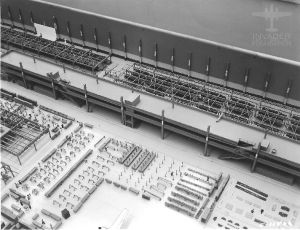
This photo shows frames 147 (left) to 129 (right) so we are looking at the east wall. The steel girder on the right edge of this photo is the same as the steel girder on the left edge of the previous photo, but I am not sure what equipment it houses. The girder from frames 132 to 138 house the jigs for manufacturing the tail assembly. The aft end of the fuselage is built here, then lined up between frames 131 and 132 where they pass underneath the spine and come out on the other side where the stabilizers are attached. Note the jig assembly in the bottom right... It shows how the A-26 fuselages are transported throughout the facility on large trolleys. There's one under the girder, shown in black, and then another one that is lined up and waiting for the tail, shown in silver.
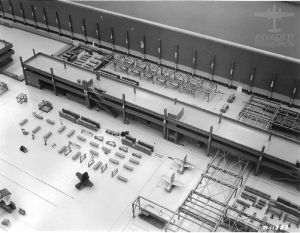
I'm not 100% sure what this is. It represents a small room of some kind. Looking at the historical photos of the Douglas Tulsa Plant, there is a small room about these approximate dimensions on the southeast corner of the building, so if I had to make a guess, I would assume that to be this building. Note that the walls are different than the main factory. This could also be one of the other smaller buildings on the property. I just don't have enough to go on to be able to say for sure. It's also unclear at present what this room is supposed to represent in terms of function.
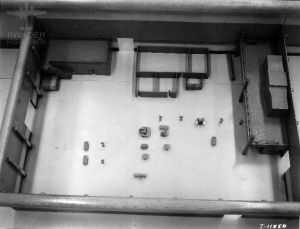
Gun Workshop
These next 5 Photos go together, but I'm not sure where in the massive building this workstation is as there are no identifying features visible that yield a clue. The photos go from right to left.
This photo shows a storage area. Along the right edge are a few completed glass noses. On the inside of the fence are a collection of A-26 upper turrets. Along the bottom of the fence next to the gate are two gunner's periscopes. The room continues on off the left edge of the image. Note the top left corner - there's a stack of weights and a small table with black boxes.
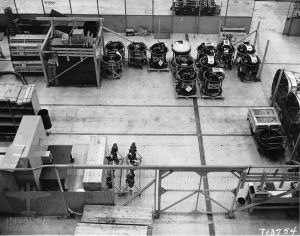
This photo butts up against the previous one. If you look in the top right corner you can see the stack of weights and the table with the black bins from the previous photo. This appears to be a gun shop. The stacked crates on the right edge are consistent with weapons crates of the time. The round frame in the bottom right is an empty turret frame. And on the left side is a rack that is holding several Browning .50 caliber guns. The wooden frame reads "A-20-G Guns", which were of the same type. It is a little surprising to find this label here as Douglas Tulsa did not build A-20s.
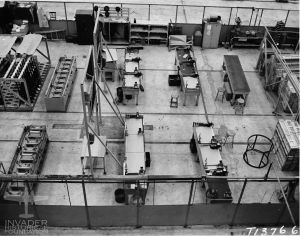
I'm reasonably sure that the previous image connects in some way to this image. There is likely a small gap of probably 1 photo's width between them. Along the bottom edge we can see 3 men working on some more gunner's periscopes. There are a half-dozen more periscopes lined up along the wall in the top edge. The center of the screen shows a worker standing beside both upper and lower turrets. The wooden platforms appear to be some kind of jig for performing work or testing the guns. Of note: pay attention to the coats and hats hanging by the door and the specific oil marks on the floor in front of the worker.

This is the same work station as the previous photo. At first I thought it might have been a secondary work station, but then I noticed the same coats in the upper right corner, and the same balding worker in the lower right. The clincher though was the same oil spots on the floor. Here we can see the other side of the testing jig. There are some turret cowlings are on the floor, and there's a distinctive pattern for 4 oil spots visible beside the frame in the center-left. There's also some kind of trolley near the top.
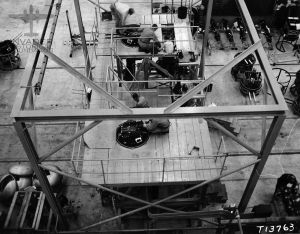
This photo shows the completed upper and lower turret assemblies after they come out of the jig. Here we can see the same trolley, the same turrets and cowlings from the previous photo, and the same distinctive 4-spot oil pattern. Note that the 3 workers in this area are on the other side of a fence and are not working on the guns. There is a single engine cowling visible along the top edge. Overall I suspect that this whole area is on the north end of the factory, as that's where we see the Invaders getting the guns installed. Based on the engine cowling, it may be located near the engine cowling fabrication section.

South End
These next 5 shots definitely go together, but I'm not 100% sure where within the factory they fit. Based on the way that the wings are aligned I am reasonably confident that this may be down along the south side of the factory. At first I had dismissed this because there were no assembly stations for the wings on the end of the factory. But then I remembered that there are a lot of loading doors on the south end of the building, and I remember that Beech Aircraft made over 1,000 pairs of A-26 wings for Douglas Tulsa so it would make sense to see a whole bunch of completed wings on the south end of the building near the loading doors. On the whole I'm not sure what fabrication is occurring in this area of the building.
The first thing that jumps out along the top edge of the photo is a row of crates lining the work areas. These crates contain the upper and lower halves of the engine cowlings. Behind them and to the right beside them are completed wing assemblies stored with the leading edge down, almost certainly delivered as completed assemblies from Beechcraft. The lower right corner is an elevated work area that connects to another similar station in the center left. The bottom left corner contains several piles of metal beams. The main area of the photo just beyond the elevated work area is a fabrication center. It's not clear to me exactly what they are fabricating. Of note: on the right side of the photo is a machine with a semi-circular hood and then a little bit to the right and above it is a cabinet with a cardboard box on top of it.

This photo is of the same area as the previous photo. The rows of engine cowlings that were on the top of the previous photo are now on the left side. The cabinet with the cardboard box I pointed out is visible in front of the wings, so we know this is the same area. There is a wall visible behind the wings, so that gives us an idea of how this space is oriented in the building, but none of the frame markers are visible. Of note are the bottom center items. Beside the two workers are manufacturing jigs for shaping metal parts. To the right of the workers is a row of items which include a table with some grey pipes on it, followed by another table with a grey box on the left side of it. On the left center of the photo is a table with some papers on it.
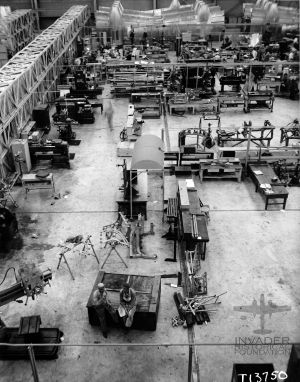
This photo shows the same area as the previous photo, but the camera has moved to the right. The workers that were in the bottom of the previous image are now just off the edge of the image. We know that this is the same area and not a different area because we can still see that same cabinet with the cardboard box at the top and at the bottom we can see the table with the pipe, the other table with the grey box, and the table with the papers. What's interesting is the bottom corner. There's a tail assembly subsection, which we learned happens near frame 130. But there's also a cockpit frame as well, which we later learn is built up on top of the central spine. Its unclear what either of these parts are doing here because they aren't manufactured in the same part of the facility, and they obviously don't go together. On the top right corner we can see that machine that has the semi-circular jig from photo 012 as well.

Once again, the same area, the camera has moved further down the right. Now the tail sub-assembly is just off frame to the left. I believe that the we are travelling North with the camera facing the west wall, but that's just my guess. Towards the top edge of the photos are visible the cabinet with the cardboard box and the machine with the semi-circular top. Along the right side is a square compartment with some compressed air cylinders and a staircase that leads up.
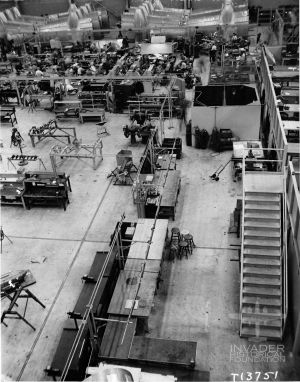
Here we can see the elevated work platform that the photographer started on in Photo 012. This reveals that the person is on a separate structure. The semi-circular machine and the compressed air cylinders are both still visible, as is the stair case. The black metal bars from the first photo in this section are along the right edge. There is a 15 visible on the wall support post on the bottom edge of the photo, which corresponds to the department number, but I don't know exactly which department that was.

Primary Fabrication
These next set of photos are all connected and appear to run along one of the central spines near the center of the building. The photos start at the south end of the central spine move to the north.
To the best of my knowledge the left side of this image is facing south, and is the south side of one of the central spines (visible as the metal wall on the right top corner). The area in the bottom of the image shows an area fabricating the nose wheel doors. On the other side of the staircase is a framework that holds Invader fuselages that have gone through the primary assembly phase and are awaiting the tail. The closest one is fuselage number 392, which is A-26C-25-DT 43-22643. Behind it is fuselage number 391, which is 43-22642, and behind that is fuselage number 390 - 43-22641. Note: Under the stairwell is a table with three pieces of paper and some black boxes, one of which has a label.
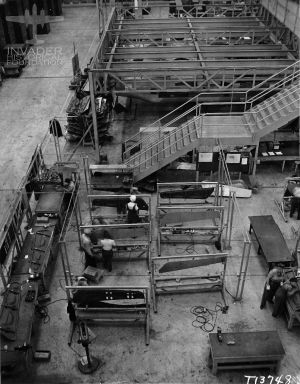
Note the left edge of this photo. There is a stairwell with a table and papers and black boxes with a label. This confirms that this photo is adjacent to the previous one. The bottom area is still the front nose gear door fabrication area. The area on the top of the stairs appear to fabricating the gunners compartment canopy. Directly underneath the spine is a central conveyor that the Invaders travel down. They move down this conver backwards (tail first). The last Invader fuselage in this row (about to go into the frame work we saw in the previous photo) is fuselage number 393 - 43-22644. (Historical Note: This plane would later become the A-26 to carry experimental skipping bombs developed by the British. She was destroyed during an accident testing those bombs at Eglin AFB on 28 Apr 1945 resulting in the loss of her crew.)
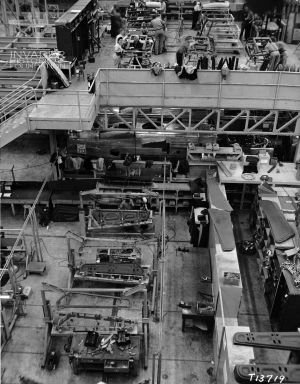
This photo is a little further down the line the previous photo. It doesn't line it up directly like the previous few did, but we can say for certain that there is a gap of not more than 1 photo's width missing between them. The plane at the end of the production trolley line was fuselage number 393. So the next plane would be 394 (43-22645), and then 395 (43-22646), and then 396 (43-22647). If we look at the center right edge of the photo we can see that one of the planes is labeled 396. So the center plane is 395, which makes the one on the right edge 394. On the top left side are completed stacks of gunner's canopies. The workers underneath appear to be installing hard metal tubes or piping inside the cockpit, probably pneumatic pressure lines for the flight control surfaces based on the shape of the tubes on top of the cabinets. Note the black cabinet on the top right and the jackets draped over the rail next to the "396" label.
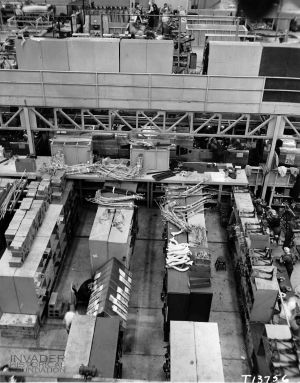
This photo immediately buts up next to the previous one. A tiny sliver of the black cabinet on the balcony can be seen on the left edge. Looking underneath the 396 is partially obscured, but the jackets draped over the rail confirm it as the same plane. To the right of it is 397 (43-22648). Notice how 396 already has the gunner's canopy in place, but 397 does not. The upper balcony just right of center is a group of workers assembling the main cockpit window frame. There are 4 cockpit frames visible, 2 by 2. The workers on the floor in front of 396 are assembling the rear wall of the cockpit as evidenced by the various tanks and pipe fittings. To the right workers are making the top gun turret housing.
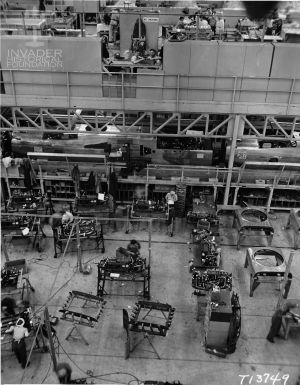
This photo has a slight gap between it and the previous one, but I am sure of the placement of this one. If you look on top of the cabinets toward center left you will see the main base plate used in making the upper turret housing from the previous photo. Also visible on top of the cabinets on the bottom edge are the plates for the assembly in the next section. On the top of the spine the fabrication for the cockpit frames continues, which is further confirmation of the placement of this photo. The two fuselages under the spine are 398 (43-22649) and 399 (43-22650). Note that both of these have the turret mount installed. Also note, on the stairs there is an assembled component on the landing.
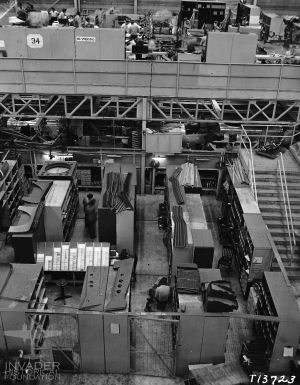
Note that the black assembly is still on the stairs, so this means that this photo butts up against the previous one. There is more cockpit fabrication going on up on top of the spine. Under the spine are fuselages 399 (43-22650) and 400 (43-22651). Note how less completed 400 is compared to the previous ones we saw. They are preparing to install the upper turret housing. The workers on the floor are assembling the "center console" that sits in the cockpit between the pilot and navigator's seats. Note the fire extinguisher on the top of the stairs.

This photo confirms my earlier belief about the direction and orientation of the items in the building. Along the back wall we can see the frame numbers, running left to right: 122 through 127, which means that South is to the left and North is to the right and the top of the photo is the west wall. If you look at the overhang on the middle of the left side you can see the fire extinguisher, so we know that this is the top of the staircase and this photo butts up against the previous one. There are some kind of assembly jigs on the top of the spine. Next to frame 126 it appears that a man is working on a wing on the far side of the room. The two planes underneath are 400 (43-22651) and 401 (43-22652). The workers on the floor continue to work on the central consoles for the cockpit. Note the pieces of black metal sticking up in the top right corner.

Towards the top of the photo we can see the same pieces of black metal, so we know this photo butts up against the previous one. The two fuselages are again 400 (43-22651) and 401 (43-22652). 401 also appears to be having the upper turret housing installed. The workers on the floor are still building the center control consoles. By looking at the row of units on the left edge it's definitively apparent what they are. The frame numbers along the top edge read 124 through 128.
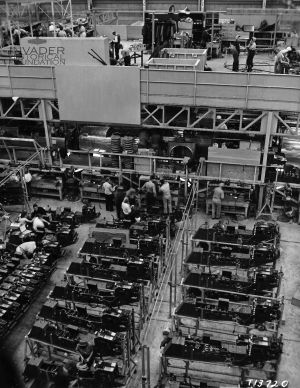
There is another small gap between this photo and the previous one. We have skipped down to the end of the spine. The last plane under the spine is fuselage 404 (43-22655). We've skipped over fuselages 402 and 403 so this photo is about 60 or 70 feet further to the north. The top of the spine appears to be staff building small precision parts. Underneath in the bottom left corner is a storage area. Note the desk with the two papers. The right side of the photo contains another housing frame, similar to the one on the south end of the spine. This frame contains 4 more fuselages: 405 (43-22656), 406 (43-22657), 407 (43-22658) and 409 (43-22659). Note towards the west end of the frame assembly there are some work areas underneath. There's a prominent No Smoking sign and behind that a pair of A-26 Wings. Pay close attention to the top right corner and look closely at the items along the wall.

At first I wasn't sure if the was the same area as the previous shot, despite having a similar jig with a similar No Smoking sign and the wings behind it. But the items along the wall confirmed that it was, indeed, the same frame. Additionally, the frame numbers listed show 130 through 134, which is consistent with what we saw in the earlier photos. I have no idea what fuselage is under this frame because it already has the upper turret housing and gunners canopy and those don't get added until later. This may be the other side of the line. In either case, this is definitely the same area as the previous photo. I've also included another shot of the wings on the rails from a different view in the factory. We know that this second shot comes from the Douglas factory because Beechcraft shipped with the wings to Douglas without engines.
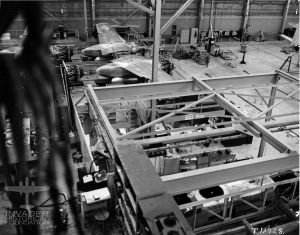
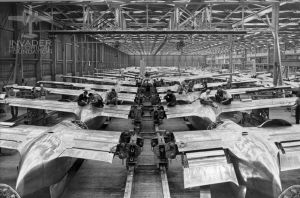
We are still looking at the fuselage frame. The same 4 fuselages sit in the frame: 405 (43-22656), 406 (43-22657), 407 (43-22658) and 409 (43-22659). Note that there is a now a worker seated at the desk inside of the storage area on the left side. On the right-middle edge of the photo take note of the white placard that says "35".
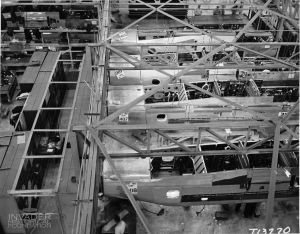
The fuselage frame is visible on the left edge. Note mid-way up the left side is the same placard that reads "35". Workers are inside of the cockpit area in the bottom left corner installing cabling. The top center of the photo contains several crates containing completed elevators ready for installation. On the floor are at least 4 mostly-complete tail assemblies (but all are missing the starboard elevator). The middle assembly reads 397 (43-22648), which was one of the two planes we saw at the South End of the spine. As the fuselages work their way to the south, the pass to the west side of the building and come back the other way. Once they reach this part of the facility again the tail is attached.
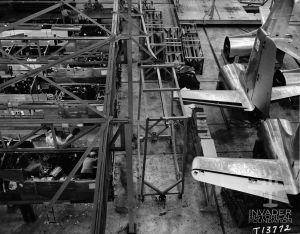
Note that this photo shows the starboard stabilizers of the two tail assemblies that were mostly visible in the previous photo. The center tail here reads 400 (43-22651) and the bottom most one in pencil reads 401 (43-22652). We can infer that the topmost tail assembly is 399 (43-22650), and we know that the first of the other two is 397 (43-22648), so the tail on the bottom is most likely 398 (43-22649). Note the materials and parts on top of the cabinets on the right side.

Note a tiny part of the tail of 401 (43-22652) is sticking up in the bottom left corner, and note the same parts and material on top of the cabinet. The work area on the right shows the beginning of the nose fabrication center. Note the nose jig in the bottom right. Also of note is the rounded frame assembly in the top right. Also note the black bag with the white card on the table in the top right.

This photo butts up with the previous one. The long frame down the center is the rounded frame from the previous photo. We can further tell because of the black bag with the white card on the table. The metal parts of the nose are being assembled on the jig. At the base of the shelves in the top right you can see several of the plexiglass panels that go on the top of the nose. The completed noses are transferred to a trolley. Note the gap in the shelving at the top right, there's a white thing and brown coat beside it.
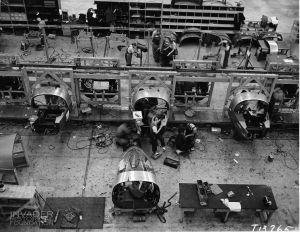
Top left corner we can see the same gap in the shelving with the same coat and white object, so we know that this photo butts up to the previous one. Noses are nearing completion on both sides of this assembly frame. Note in the top right corner is another break in the shelving with two black objects on either side.

Here we come to the end of the nose cone assembly frame. Top center of the photo shows the same opening with the same black objects. Completed nose assemblies sit on trolleys at the bottom edge. These nose cones have the holes for 2x .50 caliber machine guns. Not all C models were built that way. Sometimes the crews in the field removed the guns and patched over these holes because firing the nose guns with a bombardier inside would be excessively loud and the nose would fill up with smoke. Eventually Douglas installed a vent to combat this problem. Note, on the right edge, there's a stack of bins with a stack of weights beside it and a grey or brown fedora hat on top of them.
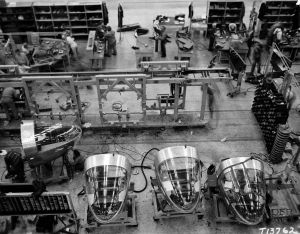
This photo butts up against the previous one. Look to the left edge and you will see the same stack of weights, bins, and the hat. This area is fabricating metal panels of some kind. I'm not sure at the moment what these panels are, but they are definitely not parts of the nose assembly as they are the wrong shape and are missing the gun ports.

Small Components
I'm not sure where or how these next photos fit in either. All I know is that we are looking west and we are towards the North end of the building because the plane partially visible has both wings and wheels, suggesting that it is nearing completion. These rooms appear to be making pneumatic parts and tires.
There's some kind of storage room with some distinctive pouches attached to one of the cabinets. I'm not sure what the black circles on the right side are. They could be part of the turret assemblies and are about the right size for that.
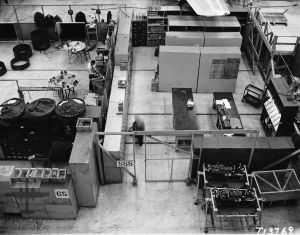
This photo butts up against the previous one. The cabinet in the storage room is the same. And so is the plane wing, the platform, and the coiled cable on top of the cabinet to the left. This main area appears to be a precision fabrication area building components for the cockpit. Note in the top-right corner; the black engine cowl, the worker in the overalls, the black machine with the vertical readouts (which appear to be a pressure testing station), and the cardboard draped over the wall along the right edge.

This photo butts up against the previous one. I wasn't sure at first, but upon closer inspection in the top left corner there's the same black cowling, the black machine, the worker with the overalls, and the cardboard draped over the wall toward the top of the photo all verify that these two photos are connected. These workbenches appear to making some kind of precision component that looks like it might be some kind of manifold. Towards the bottom edge of the photo, leaning against the fence, is a large poster with a diagram that reads "For (illegible) Cam Aligning Reference Only"
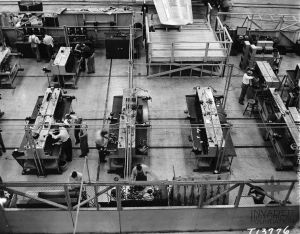
I'm not 100% sure of this photo's location, but based on the enclosure wall and the airplane wingtip visible in the photo, I am making an educated guess that it goes at some point after the previous photo with a gap of unknown space between them. This work area is making nose landing gears. Note along the right edge: the two black pyramid shaped jacks and the frames that hold the completed wheel assemblies.
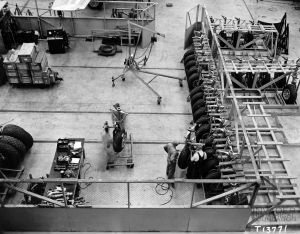
This photo butts up against the previous one. Note in the top left corner, the same black jacks and the wheel assembly frame visible along the left edge. There appears to be a wall visible in the top right corner, but I am not sure which wall this is.

Finishing Line
The next set of photos go in the opposite direction, from right to left and are travelling north down the west side of the building. They show Invaders in the finishing stages of production. I started from the last photo and worked my way backward to confirm the order.
The sign on the side of this plane reads "374", which makes this plane 43-22625. Note the worker laying on the wing.
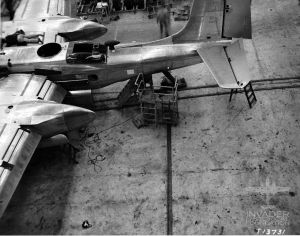
This photo is immediately to the left of the previous one. Note the man kneeling on the wing is the same man from the previous photo. The plane on the right is still 374 (43-22625). The plane on the right is 373 (43-22624).
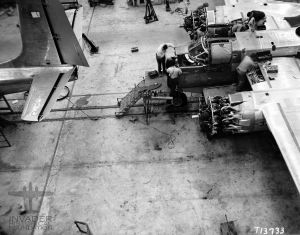
This photo shows the same two planes as the previous photo, the people have moved to different positions, but everything else is identical. Note the black tool under the starboard horizontal stabilizer and the coiled wire under the tail.
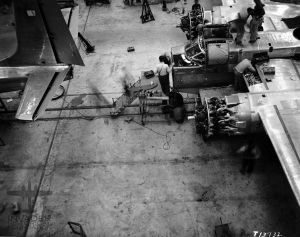
This photo is slightly to the left of the previous photo. It still shows 373 (43-22624). Note the coiled wire and and the black tool on the right edge. There's a completed nose section in the top left corner, perhaps for this plane. Note that the nose canopy is missing a panel on the pilot's side.
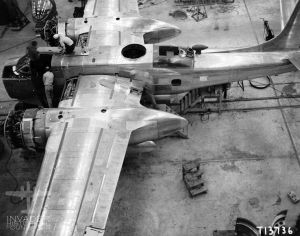
This photo appears to show the next plane in line, but is skips 372. If you look to the top of the photo you can see the same canopy and stands at the top of the photo. The plane visible on the right is also missing the panel on the right side. This plane reads 371, which is 43-22622.

This photo also shows the same view as the previous photo.
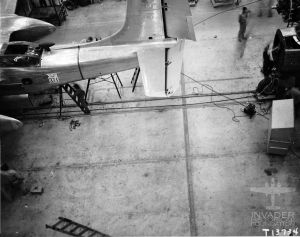
This photo shows the front half of 371 (43-22622). The next plane barely visible on the right is 370 (43-22621).
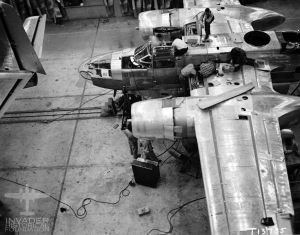
This photo shows 370 (43-22621).
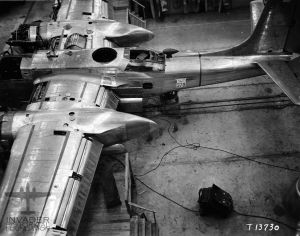
This photo shows 370 (43-22621) on the right and 369 (43-22620).
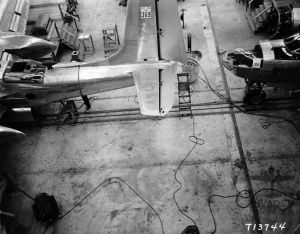
This photo shows the front half of 369 (43-22620) and the tail end of 368 (43-22619).
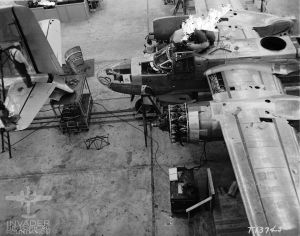
This photo skips ahead a little and shows 43-22616 (365). We know that this is a different plane because the equipment under the tail is different and the worker on the horizontal stabilizer is different as well.
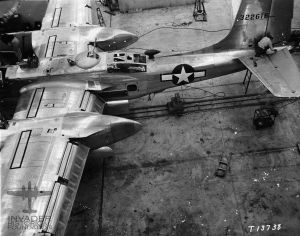
This photo appears to skip ahead again and shows 43-22614 (363).
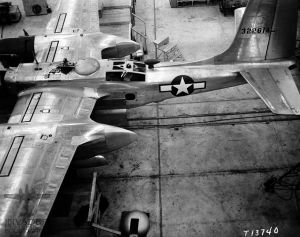
This photo shows the nose of 363 (43-22614) and the tail of 43-22613 (362).
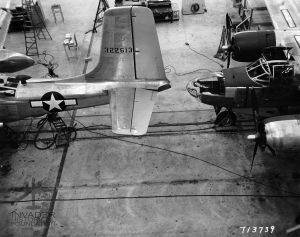
Modification Center
In the layout diagram shown above, there are two different smaller buildings in the north part of the property. These buildings are modification centers that Douglas operated. There is a photo from the Tulsa Airport Authority that alleges to be one of the first Invaders built at Tulsa. And, indeed, the Invader is an early-model invader. However, I have my doubts about this being one of the first built, especially given the plethora of images from the interior of the factory. I suspect, rather, that this plane is in one of the modification centers. There are a number of oddities, such as the presence of the bomb cart, and the testing of the hoist lift, that are simply not seen in the rest of the images. Additionally, the assembly order or planes in the production process is wholly different. Unless this plane was literally cobbled together in a corner of the factory somewhere, then I don't think what is being depicted here is a plane being built, but rather modified.
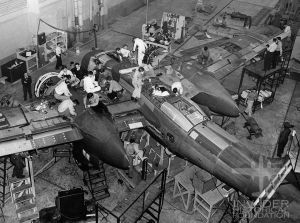
Miscellaneous Photos
This photo from the Tulsa Airport Authority shows the Douglas Tulsa factory at night in the spring of 1944. I'm not sure where, exactly this is. I don't think this is the North door. It might be one of the smaller buildings on the property.

A Douglas Newsletter showing planes parked out front of the Douglas Tulsa factory. In the front row from back to front are: 43-22687, 43-22700, and 43-22693. In the center row is 43-22697. On the far row is 43-22737. The rest of the serial numbers are illegible on this copy.
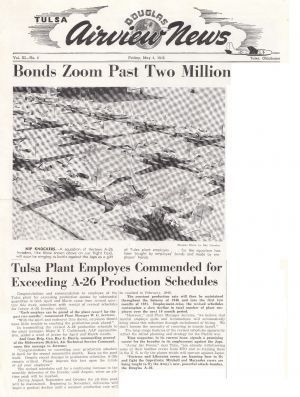
- ↑ http://cdm15020.contentdm.oclc.org/cdm/ref/collection/p16063coll1/id/8318
- ↑ 2.0 2.1 2.2 https://www.globalsecurity.org/military/facility/afp-3.htm
- ↑ https://tulsaworld.com/archive/tulsas-leap-into-aeronautics-launched-75-years-ago-with-the-bomber-plant/article_2ecc7e11-47c9-5f20-8fbc-babf2056c96d.html

